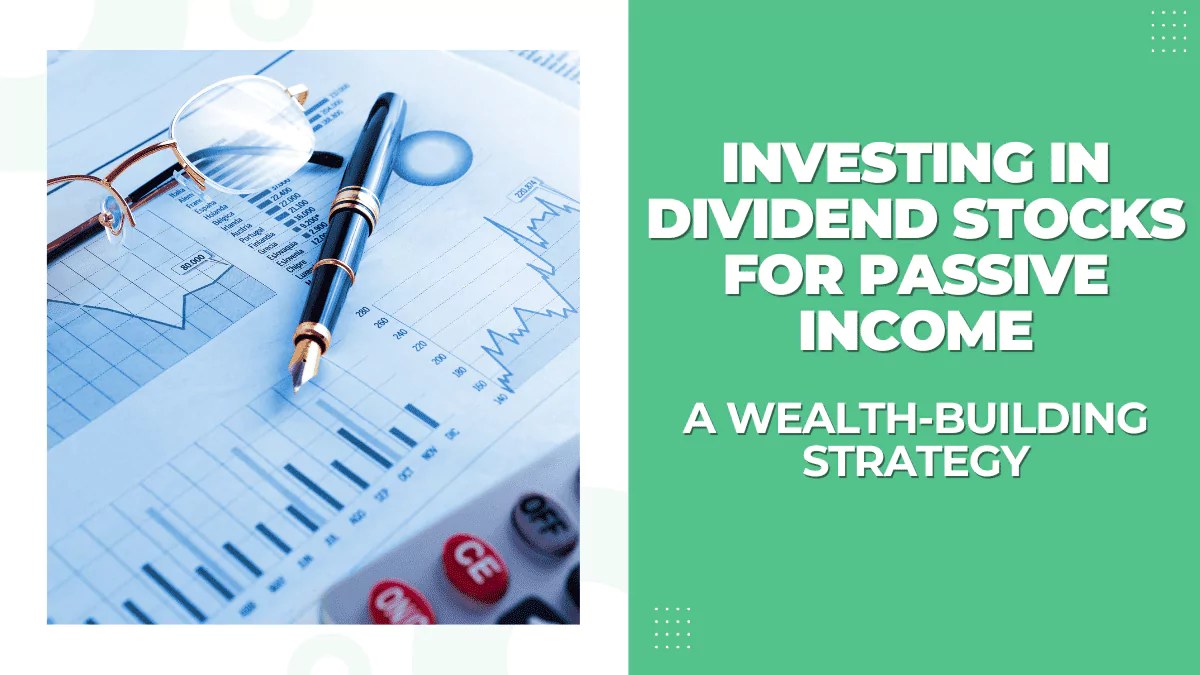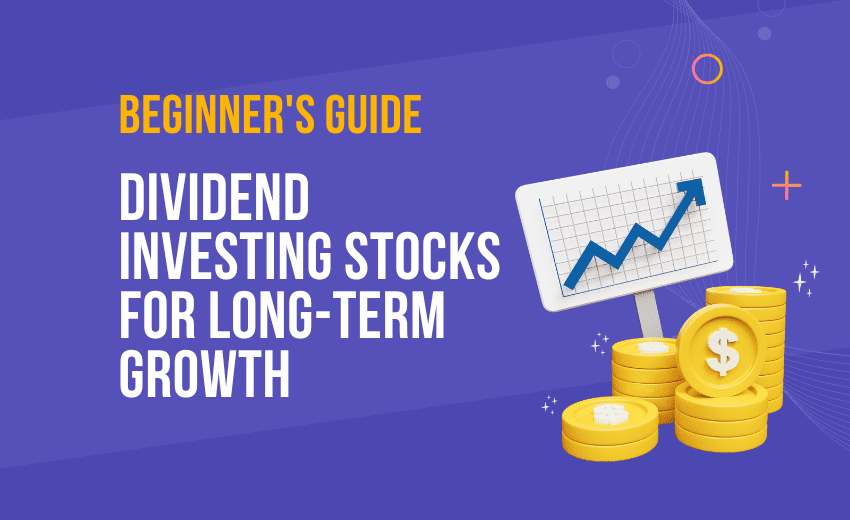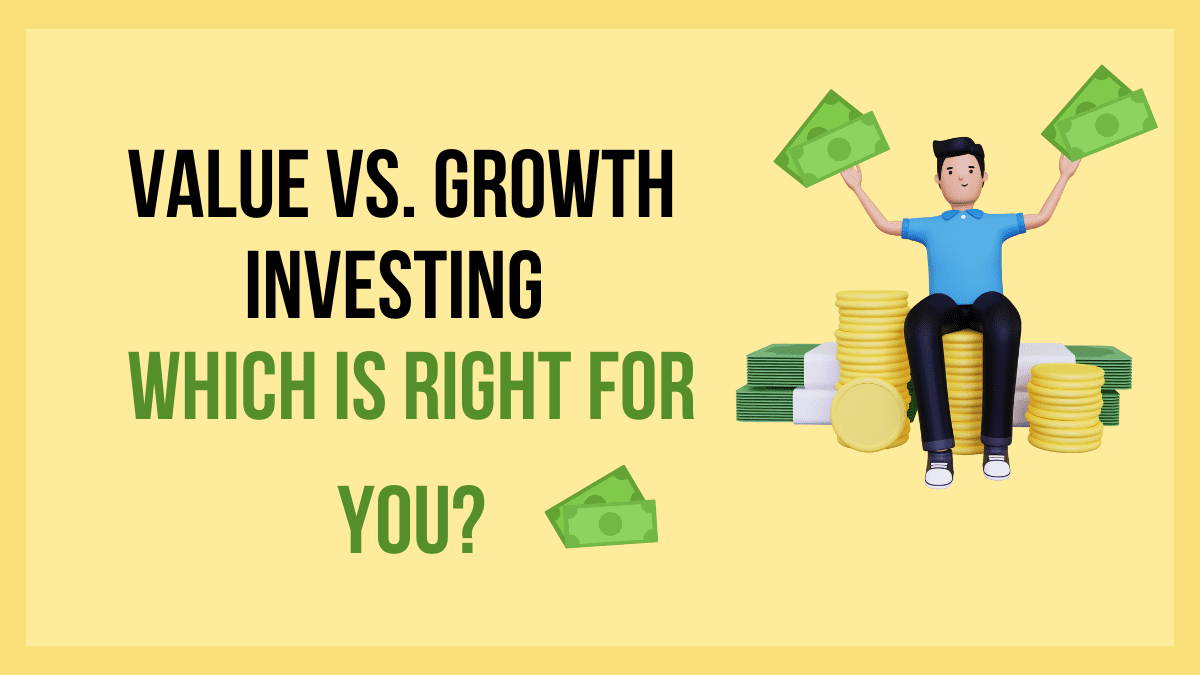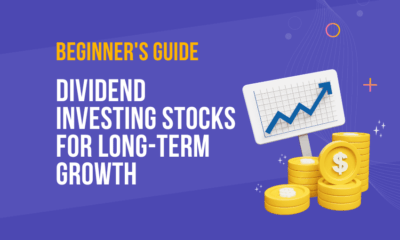Investing
Maximize Your Wealth with Dividend Stocks: The Ultimate Passive Income Strategy
Discover how to master passive income with dividend stocks. Our guide reveals the ultimate wealth-building strategy. In the dynamic world of finance, where opportunities and strategies abound.

Discover how to master passive income with dividend stocks. Our guide reveals the ultimate wealth-building strategy. In the dynamic world of finance, where opportunities and strategies abound, one method has consistently emerged as a timeless wealth-building powerhouse: dividend stocks. If you’re in search of a reliable and effective way to achieve passive income mastery, then you’re in the right place. Welcome to our comprehensive guide on how to maximize your wealth with dividend stocks—an investment strategy that has stood the test of time and continues to empower investors with financial freedom.
In this blog, we will unravel the intricacies of dividend stocks, explore the benefits they offer in generating passive income, and provide you with actionable insights to set you on the path to financial independence. Join us as we delve deep into the world of dividend stocks, uncovering the strategies that can help you achieve your financial goals and secure the future you envision.
Prepare to embark on a journey of financial empowerment as we unveil the secrets behind dividend stocks—the ultimate strategy for creating a reliable and sustainable passive income stream. Whether you’re a seasoned investor or just beginning your investment journey, this guide is your key to unlocking the full potential of your wealth. Let’s dive in!
What Are Dividend Stocks?
Let’s start by understanding what dividend stocks are and how they work. At their core, dividend stocks are shares in companies that distribute a portion of their earnings back to their shareholders in the form of dividends. These dividends are typically paid out regularly, often on a quarterly or annual basis, providing investors with a steady stream of passive income.
Why do companies pay dividends? It’s a sign of financial health and stability. Companies that consistently pay dividends are often well-established, have a history of navigating economic challenges, and are committed to rewarding their shareholders.
Advantages of Dividend Stock Investments
Investing in dividend stocks offers a host of advantages that make it an appealing choice for those seeking passive income:
1. Stability in Uncertain Times
Dividend-paying companies are generally stable and well-positioned to weather economic downturns. This stability can provide investors with peace of mind, knowing that their income source is resilient.
2. Income Generation
Perhaps the most attractive feature of dividend stocks is their ability to generate a consistent stream of income. This makes them particularly appealing to retirees or individuals looking to supplement their regular earnings.
3. Potential for Capital Growth
In addition to receiving dividends, investors may benefit from capital appreciation as the stock price increases over time. This dual advantage enhances the overall returns on your investment.
4. Compound Interest
The power of compounding cannot be overstated. Reinvesting dividends allows you to acquire more shares, which, in turn, leads to larger dividend payments. Over the long term, this can significantly boost the size of your investment portfolio.
Building Your Dividend Stock Portfolio
Now that you understand the advantages, let’s delve into how to construct a dividend stock portfolio that not only generates passive income but also aligns with SEO best practices to rank on Google.
1. Diversification is Key
Diversifying your portfolio is essential for risk management. Invest in dividend stocks from various sectors to spread risk and ensure your income remains stable, even if one sector faces challenges. Make sure to use keyword-rich titles in your content to boost SEO.
2. Research and Select Quality Stocks
Do thorough research before selecting dividend stocks. Look for companies with a strong history of consistent dividend payments, solid financials, and a competitive edge in their industry. Incorporate relevant keywords in your content to improve SEO ranking.
3. Dividend Yield Matters
Pay close attention to the dividend yield, which is the annual dividend payment as a percentage of the stock’s current price. A higher yield can mean more significant income, but be cautious of overly high yields, as they may indicate instability. Optimize your content for SEO by including relevant keywords naturally.
4. Reinvest Dividends
Consider participating in a Dividend Reinvestment Plan (DRIP) to reinvest your dividends automatically. This strategy allows you to acquire more shares over time, harnessing the power of compounding for greater wealth accumulation.
Strategies for Maximizing Dividend Income
To truly excel in the world of dividend stock investing and rank high on Google, you need to offer valuable insights and SEO-optimized content. Here are some advanced techniques:
1. Tax-Efficient Investing
Explore tax-efficient strategies by holding dividend stocks in tax-advantaged accounts. This can minimize tax liabilities and maximize your net income. Craft content that educates readers on these strategies and incorporates relevant keywords for SEO.
2. Dividend Aristocrats
Delve into the concept of dividend aristocrats, which are companies known for consistently increasing their dividends. These firms often exhibit strong financial health and a dedication to rewarding shareholders. Create content that highlights these companies and their benefits, optimizing it for SEO.
3. Monitoring and Adjusting
Regularly review your portfolio to track dividend payments and assess your holdings. Adjust your investments as needed to ensure they align with your financial goals. Offer guidance on portfolio monitoring in your content while optimizing it for SEO.
4. Global Diversification
Consider expanding your dividend portfolio to include international stocks, which can provide exposure to different markets and potentially higher yields. Craft SEO-friendly content that explores the benefits of global diversification.
In conclusion, investing in dividend stocks for passive income is a powerful wealth-building strategy that stands the test of time. It offers stability, consistent income, and the potential for long-term capital growth. By following the steps outlined in this comprehensive guide and incorporating SEO best practices, you can create a robust dividend portfolio and secure a prominent position on Google’s search results.
Success in passive income with dividend stock investing requires knowledge, patience, and a well-executed strategy. Start your journey towards financial prosperity through dividend stocks today, and watch your passive income grow.
Read More: Value vs Growth Investing: Which Is Right for You?
Stock Market
Beginner’s Guide to Dividend Investing Stocks for Long-Term Growth

Tired of the stock market roller coaster? Seeking steady income and long-term wealth creation? Look no further than dividend investing. Owning shares in companies that pay out regular portions of their profits (dividends) can be a powerful wealth-building strategy for beginners. But with so many options, choosing the right dividend-investing stocks can feel overwhelming. Fear not! This guide equips you with the knowledge to confidently navigate the world of dividend investing and select stocks poised for sustainable growth.
Why Dividend Investing for Beginners?
- Passive Income: Dividends provide a reliable stream of income, like a paycheck from your investments.
- Compounding Power: Reinvesting dividends fuels exponential growth over time.
- Market Stability: Dividend-paying companies are often established and well-managed, offering relative stability in volatile markets.
Key Considerations for Selecting Dividend Stocks:
- Dividend Yield: The percentage of a share price paid out as dividends annually. While a high yield is tempting, prioritize sustainability over immediate payout.
- Dividend History: Look for companies with a track record of consistent or increasing dividends, showcasing financial strength and commitment to shareholder returns.
- Financial Health: Analyze the company’s earnings, debt, and cash flow to ensure it can maintain dividend payments.
- Growth Potential: Don’t just settle for income; choose companies with opportunities for future growth, boosting your overall returns.
Ready to Start? Here are 3 Beginner-Friendly Dividend Investing Stocks:
- Johnson & Johnson (JNJ): A healthcare giant with a 58-year streak of increasing dividends, JNJ offers stability and a solid yield of 2.7%.
- Consumer Staples Sector (Consumer Staples ETFs like XLP): Invest in a basket of essential goods companies like food and beverages, known for their consistent payouts and defensive nature during market downturns.
- Real Estate Investment Trusts (REITs): These companies own and manage income-producing real estate, offering attractive yields (around 4-5%) and diversification benefits.
Remember: Dividend investing stocks is a long-term strategy. Conduct thorough research, diversify your portfolio, and be patient. With the right approach, dividend stocks can be a cornerstone of your successful investment journey.
Bonus Tip: Consider dividend reinvestment plans (DRIPs) to automatically reinvest your dividends, accelerating your wealth creation.
Disclaimer: This article is for informational purposes only and should not be considered financial advice. Please consult a qualified financial advisor before making any investment decisions.
Read More: Maximize Your Wealth with Dividend Stocks: The Ultimate Passive Income Strategy
Investing
Unlocking the Power of Bonds and Fixed-Income Investments: Your Ultimate Beginner’s Guide
Unlocking the Power of Bonds and Fixed-Income Investments. Investing your hard-earned money wisely is a critical step towards financial security and growth.

Unlocking the Power of Bonds and Fixed-Income Investments. Investing your hard-earned money wisely is a critical step towards financial security and growth. While many investment options are available, bonds and fixed-income investments stand out as a reliable choice, particularly for beginners. In this comprehensive guide, we will explore the world of Bonds and Fixed-Income Investments, offering valuable insights to help beginners navigate this essential aspect of the financial world.
What Are Bonds?
Bonds, often referred to as fixed-income securities, are essentially IOUs issued by governments, municipalities, or corporations. When you invest in a bond, you’re lending your money to the issuer in exchange for periodic interest payments (coupon payments) and the return of your initial investment when the bond matures. Bonds come in various forms, each catering to different investment needs:
Government Bonds
These are issued by governments to raise funds for various purposes, such as infrastructure development and debt management. Government bonds are often considered one of the safest investments due to the backing of the government.
Corporate Bonds
Companies issue corporate bonds to raise capital for operations, expansion, or other financial needs. Corporate bonds may offer higher yields compared to government bonds but come with a slightly higher level of risk.
Municipal Bonds
Municipalities issue bonds to finance public projects like schools and highways. They are attractive to investors because the interest income may be exempt from federal and state taxes, making them tax-efficient investments.
Why Invest in Bonds?
For beginners, bonds offer several compelling reasons to consider them as part of their investment portfolio:
1. Steady Income
Bonds provide a regular stream of income through coupon payments, making them an ideal choice for investors seeking predictable cash flow.
2. Safety and Stability
Compared to the often volatile stock market, bonds are generally considered a safer and more stable investment. They can act as a stabilizing force in your portfolio.
3. Diversification
Diversifying your investments across asset classes is essential for risk management. Bonds offer an opportunity to diversify your portfolio and spread risk effectively.
4. Preservation of Capital
Most bonds return the face value upon maturity, ensuring the preservation of your initial investment. This capital preservation is particularly important for conservative investors.
How to Start Investing in Bonds
Are you eager to start your bond investment journey? Here’s a step-by-step guide for beginners:
1. Determine Your Investment Goals
Begin by setting clear investment goals. Are you looking for steady income, wealth preservation, or diversification? Understanding your objectives will help you choose the right bonds.
2. Understand Risk Tolerance
Assess your risk tolerance level. Different bonds come with varying degrees of risk. Knowing your comfort zone is crucial when selecting the type of bonds to invest in.
3. Research Bond Options
Explore the different types of bonds available, such as government, corporate, and municipal bonds. Learn about their characteristics, risk factors, and potential returns.
4. Open an Investment Account
Choose a reputable brokerage or financial institution to open an investment account. Your chosen platform will play a significant role in your bond investment journey.
5. Build a Diverse Portfolio
Diversification is key to managing risk. Invest in bonds with different maturities, issuers, and credit ratings to spread risk effectively.
6. Monitor Your Investments
Keep a close eye on your bond holdings. Track coupon payments, stay informed about any issuer developments, and be prepared for bond maturity dates.
Types of Bond Risks
While bonds are generally considered safer than stocks, they are not entirely risk-free. Here are some risks associated with bond investments:
Interest Rate Risk
Bond prices can fluctuate inversely with interest rates. When interest rates rise, bond prices tend to fall, and vice versa.
Credit Risk
There’s always the possibility that the issuer may default on its payments. Credit risk varies between bonds, with corporate bonds generally carrying higher credit risk than government bonds.
Inflation Risk
Inflation can erode the purchasing power of the fixed coupon payments received from bonds. Investors need to consider this risk when planning their bond investments.
Liquidity Risk
Some bonds may be less liquid than others, meaning they are not as easy to buy or sell in the market. This can impact the ease of trading and the price you receive.
Market Risk
Overall market conditions, economic events, and geopolitical factors can influence bond prices and returns.
Building a Diverse Bond Portfolio
Diversification is a key strategy for managing risk and optimizing returns. A diverse bond portfolio might include:
A mix of government, corporate, and municipal bonds.
Bonds with varying maturities, from short-term to long-term.
Bonds with different credit ratings, from high-quality (investment-grade) to lower-quality (high-yield or junk bonds).
By diversifying your bond holdings, you can spread risk across different assets and potentially enhance your overall portfolio performance.
Monitoring Your Bond Investments
Once you’ve built your bond portfolio, it’s essential to monitor it regularly:
Keep track of coupon payments and reinvest them if needed.
Stay informed about any developments related to the issuers of your bonds.
Be prepared for bond maturity and decide whether to reinvest or cash out.
FAQs (Frequently Asked Questions)
Q: Can I lose money by investing in bonds?
A: While bonds are generally considered less risky than stocks, they are not entirely risk-free. Factors such as interest rate fluctuations and issuer defaults can impact bond investments.
Q: How do I buy bonds?
A: You can buy bonds through brokerage accounts, mutual funds, or directly from the issuer. Brokerage accounts offer convenience and access to a variety of bonds.
Q: What is the difference between coupon rate and yield?
A: The coupon rate is the fixed interest rate a bond pays, while the yield reflects the bond’s total return, accounting for changes in its market price.
Q: Can I sell my bonds before they mature?
A: Yes, you can sell your bonds in the secondary market before they mature. However, the market price may be higher or lower than the face value.
Q: Are bonds suitable for long-term investment?
A: Yes, bonds can be a suitable long-term investment, especially for those seeking income and stability in their portfolio.
Q: How are bond interest payments taxed?
A: Bond interest is subject to taxation. Government bonds may have tax advantages, while corporate bond interest is typically taxed at your ordinary income rate.
As you’ve journeyed through this Beginner’s Guide to Bonds and Fixed-Income Investments, you’ve gained essential insights into this stable and reliable investment option. Bonds offer a combination of steady income, safety, and the potential for capital preservation—all critical elements for beginners seeking financial security.
To achieve your financial goals, remember that successful investing requires careful planning, diversification, and a clear understanding of your objectives. Bonds can play a vital role in your investment strategy, providing you with a solid foundation for building your wealth.
Don’t hesitate to explore the world of Bonds and Fixed-Income Investments further, and embark on your investment journey with confidence. Your financial future awaits!
Read More: Maximize Your Wealth with Dividend Stocks: The Ultimate Passive Income Strategy
Investing
Value vs Growth Investing: Which Is Right for You?
Learning Value vs Growth Investing from successful investors can be enlightening. Consider stories like Warren Buffett’s value-focused approach .

Value vs Growth Investing
Value vs. Growth Investing is a crucial aspect of building wealth and securing your financial future. However, the decision of where to invest your hard-earned money can be challenging. One of the fundamental debates in the world of investing is between “Value” and “Growth” investing. In this blog post, we will delve into the differences between these two investment strategies, helping you determine which one might be the right fit for you.
Section 1: What is Value Investing?
Value Investing Defined
Value investing is a strategy that focuses on purchasing stocks that are undervalued in the market. The core principle is to find stocks that are trading below their intrinsic or “true” value.
Characteristics of Value Stocks
Value stocks typically have some common characteristics:
Lower Price-to-Earnings (P/E) ratios
Steady dividend payments
Established companies with a long track record
Conservative approach to debt
Historical Performance of Value Investing
Value investing has a rich history of success. Legendary investors like Warren Buffett and Benjamin Graham are prime examples of value investors who have consistently outperformed the market over the long term.
The Contrarian Approach of Value Investing
Value investing often takes a contrarian approach. Instead of following market trends and popular stocks, value investors search for hidden gems that have been overlooked by the broader market. They believe that these undervalued stocks will eventually be recognized and appreciated in value.
Value Investing and Margin of Safety
One of the key principles of value investing is the concept of a “margin of safety.” This means buying stocks at a price significantly below their intrinsic value to protect against potential losses.
Section 2: What is Growth Investing?
Growth Investing Defined
Growth investing, on the other hand, is a strategy that focuses on companies with high potential for future growth. This approach typically involves investing in companies with above-average revenue and earnings growth.
Characteristics of Growth Stocks
Growth stocks exhibit several key characteristics:
Higher Price-to-Earnings (P/E) ratios
Reinvestment of earnings into the business for expansion
Potential for rapid revenue and earnings growth
May not pay dividends
Historical Performance of Growth Investing
Growth investing has also delivered impressive returns over time. Companies like Amazon and Apple exemplify growth stocks that have rewarded investors handsomely.
The Momentum Aspect of Growth Investing
Growth investors often rely on momentum and trends. They believe that stocks with strong growth potential will continue to rise as more investors jump on board.
Growth Investing and Innovation
Many growth stocks are associated with innovative industries such as technology and biotech. Investors in growth stocks often anticipate that these companies will disrupt traditional markets and generate substantial returns.
Section 3: Value vs. Growth – Key Differences
When deciding between value and growth investing, it’s crucial to understand the key differences.
Risk and Return Profiles
Value stocks are often considered less risky but may offer more modest returns. In contrast, growth stocks can provide substantial returns but come with higher volatility.
Factors Influencing the Choice
The choice between value and growth investing should consider factors like your risk tolerance, investment timeline, and financial goals.
Section 4: Factors to Consider When Choosing
Choosing between value and growth investing isn’t one-size-fits-all. Consider these factors:
Risk Tolerance
Assess your comfort level with market fluctuations. If you prefer stability, value investing may be more appealing.
Financial Goals
Your financial objectives play a pivotal role. If you’re looking for long-term growth, growth investing might align better with your goals.
Time Horizon
Consider how long you intend to invest. Value investing is often associated with a longer investment horizon.
Diversification
Regardless of your choice, diversification is crucial. A well-balanced portfolio may include a mix of both value and growth stocks to mitigate risks.
Section 5: Pros and Cons of Value Investing
Pros
Lower risk
Dividend income
Steady returns
Cons
Potential for slower growth
May miss out on high-flying stocks
Section 6: Pros and Cons of Growth Investing
Pros
Potential for high returns
Capital appreciation
Aligns with long-term growth objectives
Cons
Higher volatility
Lower dividend income
Section 7: Building a Balanced Portfolio
Diversification is key. Consider blending value and growth stocks to create a balanced portfolio that suits your risk tolerance and objectives.
Section 8: Expert Opinions and Recommendations
Experts often suggest a diversified approach that incorporates both value and growth stocks. However, the right mix depends on your individual circumstances.
Section 9: Real-Life Success Stories
Learning from successful investors can be enlightening. Consider stories like Warren Buffett’s value-focused approach and the rapid growth of tech companies in the growth investing realm.
Conclusion
The choice between value and growth investing ultimately hinges on your unique financial situation, objectives, and risk tolerance. There’s no one-size-fits-all answer. Consider seeking professional advice and remember that a balanced approach may offer the best of both worlds.
Additional Resources
For further exploration, check out the following resources:
List of recommended books on investing
Websites for in-depth financial analysis
Tools for tracking your investments
We hope this comprehensive guide has shed light on the value vs. growth investing dilemma. Share your thoughts and questions in the comments below, and don’t forget to subscribe for more valuable investment insights. Follow us on social media for the latest updates on financial strategies and market trends.
Read More: Diversifying Your Investment Portfolio: Strategies and Benefits
Stock Market Trends: What to Watch for in 2023













Pingback: Unlocking the Power of Bonds and Fixed-Income Investments: Your Ultimate Beginner’s Guide
Pingback: Sleep Your Way to Wealth: Exploring Passive Income Streams
Pingback: How to Buy and Store Cryptocurrency Safely
Pingback: can somebody write my essay
Pingback: Beginner’s Guide to Dividend Investing Stocks for Long-Term Growth | SmartMoneyQuest